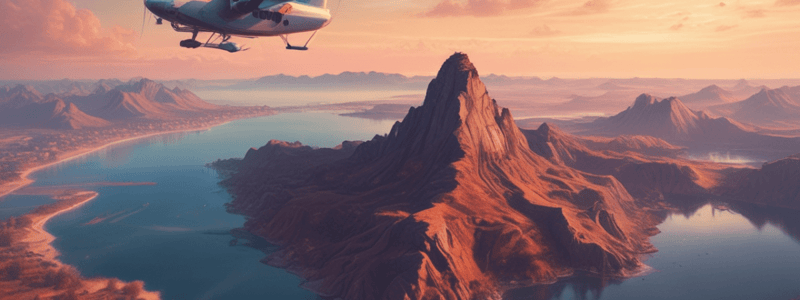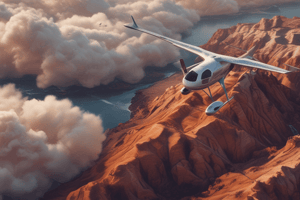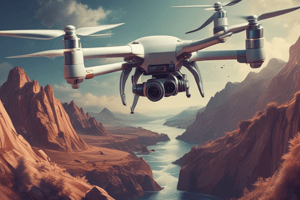Podcast
Questions and Answers
What is the purpose of using an ND filter in aerial videography?
What is the purpose of using an ND filter in aerial videography?
- To enhance finger placement on the remote
- To reduce shutter speed
- To increase frame rate
- To ensure proper exposure in most lighting conditions, unless it's overcast (correct)
What is the recommended shutter speed for smooth shots in aerial videography?
What is the recommended shutter speed for smooth shots in aerial videography?
- One-third the frame rate
- Half the frame rate
- Equal to the frame rate
- Double the frame rate (correct)
What is the primary reason for recording 10-15 seconds after the select shot?
What is the primary reason for recording 10-15 seconds after the select shot?
- To showcase the drone's capabilities
- To capture additional footage
- To ensure subject tracking
- To have a nice transition or buffer footage (correct)
What is a key objective of the aerial videography course?
What is a key objective of the aerial videography course?
What type of shot is NOT covered in the aerial videography course?
What type of shot is NOT covered in the aerial videography course?
What is a benefit of taking the aerial videography course?
What is a benefit of taking the aerial videography course?
What is the primary goal of mastering the skills taught in the aerial videography course?
What is the primary goal of mastering the skills taught in the aerial videography course?
The aerial videography course covers subject tracking.
The aerial videography course covers subject tracking.
It is recommended to always use an ND filter, regardless of the weather conditions.
It is recommended to always use an ND filter, regardless of the weather conditions.
Recording for 10-15 seconds after the select shot is recommended to ensure a smooth transition.
Recording for 10-15 seconds after the select shot is recommended to ensure a smooth transition.
The course teaches students how to produce fast-paced, action-packed footage.
The course teaches students how to produce fast-paced, action-packed footage.
The course objective is to learn the right settings, drones, and accessories for aerial photography.
The course objective is to learn the right settings, drones, and accessories for aerial photography.
By the end of the course, pilots will be able to produce low-quality, shaky footage.
By the end of the course, pilots will be able to produce low-quality, shaky footage.
The course covers various types of shots, including crane shots, reveal shots, and sliding shots.
The course covers various types of shots, including crane shots, reveal shots, and sliding shots.
Flashcards are hidden until you start studying
Study Notes
Aerial Videography Course
- The course is designed to help drone pilots master confidence in getting smooth shots, including crane shots, reveal shots, sliding shots, orbital shots, and more.
Key Formula for Smooth Shots
- Always use an ND filter unless it's overcast.
- Ensure shutter speed is double the frame rate.
- Don't forget to hit the auto exposure lock button.
Best Practices for Recording
- Only shoot select shots to avoid unnecessary footage and easier organization.
- Record for 10-15 seconds after the select shot to have a nice transition or buffer footage.
Course Objectives
- Learn the right settings, drones, accessories, and motions for aerial videography.
- Gain tips and tricks for smooth shots, including finger placement on the remote.
- Practice and master the skills to produce high-quality, cinematic footage.
Course Coverage
- The course covers crane shots, orbit shots, reveal shots, slit sides, and more.
- It does not cover subject tracking, which is a separate course.
Benefits
- By the end of the course, pilots will be able to produce smooth, cinematic footage that impresses clients.
- The course will help pilots master the skills to produce visually appealing footage that evokes an emotional response.
Aerial Videography Course
- Designed to help drone pilots master confidence in getting smooth shots.
Key Formula for Smooth Shots
- Always use an ND filter unless it's overcast.
- Shutter speed should be double the frame rate.
- Don't forget to hit the auto exposure lock button.
Best Practices for Recording
- Shoot select shots to avoid unnecessary footage and easier organization.
- Record for 10-15 seconds after the select shot for a nice transition or buffer footage.
Course Objectives
- Learn the right settings, drones, accessories, and motions for aerial videography.
- Gain tips and tricks for smooth shots, including finger placement on the remote.
- Practice and master skills to produce high-quality, cinematic footage.
Course Coverage
- Covers crane shots, orbit shots, reveal shots, slit sides, and more.
- Does not cover subject tracking, which is a separate course.
Benefits
- Produce smooth, cinematic footage that impresses clients.
- Master skills to produce visually appealing footage that evokes an emotional response.
Aerial Videography Course
- Designed to help drone pilots master confidence in getting smooth shots.
Key Formula for Smooth Shots
- Always use an ND filter unless it's overcast.
- Shutter speed should be double the frame rate.
- Don't forget to hit the auto exposure lock button.
Best Practices for Recording
- Shoot select shots to avoid unnecessary footage and easier organization.
- Record for 10-15 seconds after the select shot for a nice transition or buffer footage.
Course Objectives
- Learn the right settings, drones, accessories, and motions for aerial videography.
- Gain tips and tricks for smooth shots, including finger placement on the remote.
- Practice and master skills to produce high-quality, cinematic footage.
Course Coverage
- Covers crane shots, orbit shots, reveal shots, slit sides, and more.
- Does not cover subject tracking, which is a separate course.
Benefits
- Produce smooth, cinematic footage that impresses clients.
- Master skills to produce visually appealing footage that evokes an emotional response.
Studying That Suits You
Use AI to generate personalized quizzes and flashcards to suit your learning preferences.




